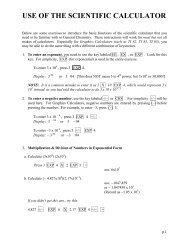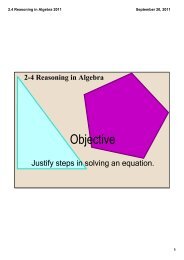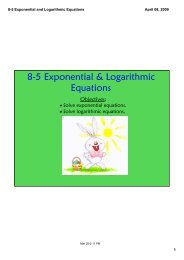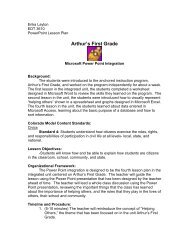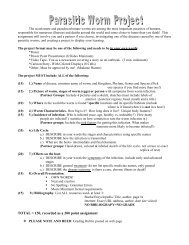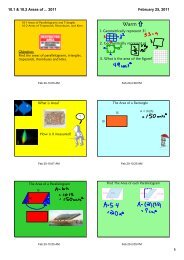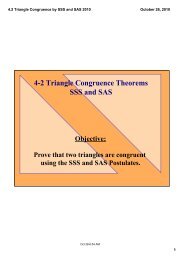Structure of the Electron Cloud PowerPoint
Structure of the Electron Cloud PowerPoint
Structure of the Electron Cloud PowerPoint
Create successful ePaper yourself
Turn your PDF publications into a flip-book with our unique Google optimized e-Paper software.
Levels <strong>of</strong> Organization• The term, ‘electron cloud’ doesn’t tell usvery much about electron location.• This cloud is actually highly structured.• It is divided into:– Principal energy levels (PELs or shells )• Energy sublevels (or subshells)–Orbitals
PEL Review• Atoms may have from 1-7 PELs that areconcentric spheres.• Level 1 is closest to <strong>the</strong> nucleus andlevel 7 found only with <strong>the</strong> largestatoms is <strong>the</strong> highest PEL.
Energy Sublevels• Principal energy levels are subdividedinto 1-4 sublevels, depending on howlarge <strong>the</strong> PEL is.• Sublevels are designated as s, p, d andf.• Each sublevel has a different number <strong>of</strong>orbitals, and <strong>the</strong> orbitals have differentshapes.
Orbitals• An orbital is <strong>the</strong> region <strong>of</strong> space where<strong>the</strong>re is a 90% probability <strong>of</strong> finding anelectron <strong>of</strong> a particular energy.• A single orbital may be home to 1 or 2electrons, but never more than 2.
The ‘s’ sublevel• The ‘s’ sublevel is <strong>the</strong> simplest.• It has only 1 orbital, which is a sphere.• The orbital can house 2 electrons.
Reality• Please keep in mind that orbitals arenot solid shapes as <strong>the</strong> previous picturesuggests. The sphere represents 90%electron density.• A real orbital would probably have afuzzy appearance, more like this.
The ‘p’ sublevel• The ‘p’ sublevel is largerthan <strong>the</strong> ‘s’ and consists<strong>of</strong> 3 orbitals which eachlook like this.• The p-orbital is bi-lobedand can also house 2electrons.• The grey circle in <strong>the</strong>center represents <strong>the</strong> s-orbital.
The ‘p’ sublevelz• The ‘p’ sublevelconsists <strong>of</strong> 3orbitals, each atright angles to eacho<strong>the</strong>r in space.• Thus, <strong>the</strong> entiresublevel can hold upto 6 electrons total.yx
The ‘p’ sublevelz• The 3 orbitals <strong>of</strong> <strong>the</strong>p-sublevel aredesignated as p x , p yand p z for <strong>the</strong> 3axes upon which<strong>the</strong>y lie in space.yx
The ‘d’ sublevel• The ‘d’ sublevel consists <strong>of</strong> 5 orbitalswhose shapes are more complex.• The sublevel can house 10 electrons.• The orbitals have 2 different types <strong>of</strong>shapes, and are oriented in space so asnot to overlap each o<strong>the</strong>r.
d- orbitals• Four <strong>of</strong> <strong>the</strong> d-orbitals look likethis.The fifth d-orbitallooks like this.
‘d’ sublevel• Altoge<strong>the</strong>r, <strong>the</strong> d-orbitals occupy acommon space, butdo not overlap eacho<strong>the</strong>r.• The whole sublevellooks like this.
‘f’ sublevel• The ‘f’ sublevel has 7 orbitals, home to 14electrons and is much more complex.• The orbitals look like this.
Heisenberg Uncertainty Principle• The whole idea that electrons occupy 3-dimensional volumes <strong>of</strong> space camefrom Werner Heisenberg who said thatwas impossible to know both <strong>the</strong> speedand location <strong>of</strong> tiny, fast-movingelectrons at <strong>the</strong> same time.• This became know as <strong>the</strong> “HeisenbergUncertainty Principle.”
Pauli Exclusion Principle• Ano<strong>the</strong>r famousphysicist, WolfgangPauli stated that asingle atomic orbital,regardless <strong>of</strong> size orshape can only hold2 electrons, andthose electrons musthave opposite spin.
<strong>Electron</strong> Spin• Like charge, particleshave ano<strong>the</strong>r qualitycalled ‘spin.’• There are only 2possible values,parallel (up) or antiparallel(down).
Putting It All Toge<strong>the</strong>r• PEL 1 is small and ‘close’ to <strong>the</strong> nucleus.• It only has 1 sublevel, an ‘s’ and so hasroom for only 2 electrons.• When <strong>the</strong> 1 st PEL is filled with 2 e - , <strong>the</strong>next electrons must go into <strong>the</strong> 2 nd PEL.
Putting It All Toge<strong>the</strong>r• The 2 nd PEL is larger, and so has roomfor more electrons.• It has an ‘s’ sublevel, and a ‘p’ sublevel.• The ‘s’ has room for 2 e - while <strong>the</strong> ‘p’sublevel with its 3 orbitals, has room for6 more, giving a total <strong>of</strong> 8 electrons in<strong>the</strong> 2 nd PEL.
Putting It All Toge<strong>the</strong>r• PEL 3 is larger still, and has room for agreater number <strong>of</strong> electrons.• It has s, p and d sublevels.• The ‘s’ sublevel can hold 2 e - , <strong>the</strong> ‘p’can hold 6, and <strong>the</strong> ‘d’ can hold 10 (5orbitals) for a total <strong>of</strong> 18.
Putting It All Toge<strong>the</strong>r• PELs 4-7 all have s, p, d, and f possiblesublevels.• s 2 e - (1 orbital)• p 6 e - (3 orbitals)• d 10 e - (5 orbitals)• f 14 e - (7 orbitals)• Total <strong>of</strong> 32 electrons.
A Helpful TablePEL1 2 3 4 5-7Sublevelss s / p s p d s p d f Same as4OrbitalsInSublevele- insublevelTotal e- inPEL1 1 / 3 1/3/5 1/3/5/7 Same as42 2 / 6 2/6/10 2/6/10/14 Same as42 8 18 32 Same as4



